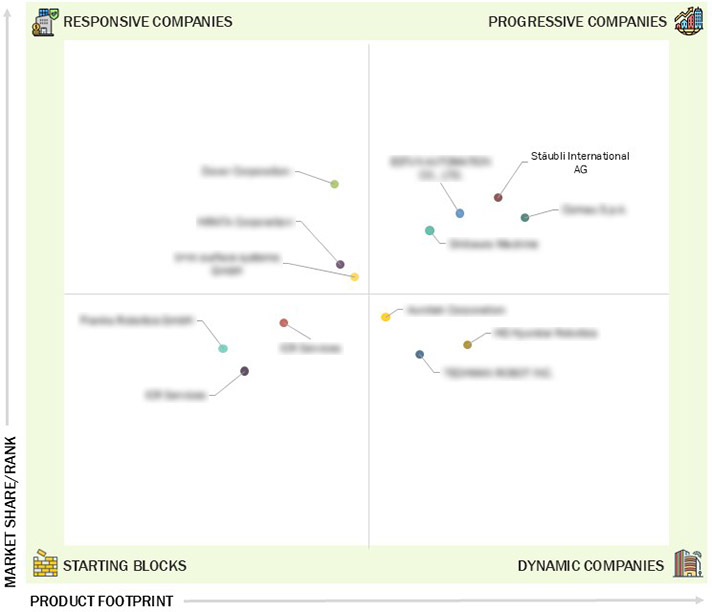Comparing 12 vendors in Automotive Manufacturing Equipment Startups across 0 criteria.
The automotive manufacturing equipment market is witnessing dynamic growth driven by innovation and strategic expansion among startups and SMEs. Companies are categorized based on their product strength and market presence, with progressive firms offering tailored solutions and responsive ones focusing on future-ready innovations. Dynamic companies leverage extensive partner networks to boost deployment across industries, while those in the starting blocks face challenges in scaling and integration. This segmentation highlights the evolving competitive landscape, where firms adopt varied strategies to enhance visibility, meet customer demands, and strengthen their market positions.
Market Leadership Quadrant
1.1 Study Objectives
1.2 Market Definition
1.3 Study Scope
1.3.1 Markets Covered and Regional Scope
1.3.2 Inclusions and Exclusions
1.3.3 Years Considered
1.4 Currency Considered
1.5 Units Considered
1.6 Limitations
1.7 Stakeholders
1.8 Summary of Changes
2.1 Introduction
2.2 Market Dynamics
2.2.1 Drivers
2.2.1.1 Elevated sales of electric and hybrid vehicles globally
2.2.1.2 Increased reliance on automation by OEMs in developed
countries to boost cost efficiency
2.2.1.3 High adoption of Industry 4.0 technologies by automakers
2.2.2 Restraints
2.2.2.1 High installation and ownership costs for SMEs
2.2.3 Opportunities
2.2.3.1 Increasing demand for ML and AI by automobile companies
2.2.3.2 Thriving automotive sector in emerging economies
2.2.4 Challenges
2.2.4.1 Vulnerability of industrial manufacturing systems to
cyberattacks
2.2.4.2 Interoperability and integration-related issues
2.3 Value Chain Analysis
2.4 Ecosystem Analysis
2.5 Trends/Disruptions Impacting Customer Business
2.6 Impact of Gen AI/AI on Automotive Manufacturing Equipment Market
2.7 Technology Analysis
2.7.1 Complementary Technologies
2.7.1.1 Industrial Internet of Things and artificial intelligence
2.7.1.2 Robotic vision
2.7.1.3 Safety sensor-enabled industrial robots
2.8 Key Conferences and Events, 2025–2026
2.9 Porter’s Five Forces Analysis
2.9.1 Threat of New Entrants
2.9.2 Threat of Substitutes
2.9.3 Bargaining Power of Suppliers
2.9.4 Bargaining Power of Buyers
2.9.5 Intensity of Competitive Rivalry
2.10 Impact of US Tariff on Automotive Manufacturing Equipment Market
2.10.1 Introduction
2.10.2 Key Tariff Rates
2.10.3 Price Impact Analysis
2.10.4 Impact on Countries/Regions
2.10.4.1 US
2.10.4.2 Europe
2.10.4.3 Asia Pacific
2.10.5 Impact on Vehicle Types
2.1 Introduction
2.2 Market Dynamics
2.2.1 Drivers
2.2.1.1 Elevated sales of electric and hybrid vehicles globally
2.2.1.2 Increased reliance on automation by OEMs in developed
countries to boost cost efficiency
2.2.1.3 High adoption of Industry 4.0 technologies by automakers
2.2.2 Restraints
2.2.2.1 High installation and ownership costs for SMEs
2.2.3 Opportunities
2.2.3.1 Increasing demand for ML and AI by automobile companies
2.2.3.2 Thriving automotive sector in emerging economies
2.2.4 Challenges
2.2.4.1 Vulnerability of industrial manufacturing systems to
cyberattacks
2.2.4.2 Interoperability and integration-related issues
2.3 Value Chain Analysis
2.4 Ecosystem Analysis
2.5 Trends/Disruptions Impacting Customer Business
2.6 Impact of Gen AI/AI on Automotive Manufacturing Equipment Market
2.7 Technology Analysis
2.7.1 Complementary Technologies
2.7.1.1 Industrial Internet of Things and artificial intelligence
2.7.1.2 Robotic vision
2.7.1.3 Safety sensor-enabled industrial robots
2.8 Key Conferences and Events, 2025–2026
2.9 Porter’s Five Forces Analysis
2.9.1 Threat of New Entrants
2.9.2 Threat of Substitutes
2.9.3 Bargaining Power of Suppliers
2.9.4 Bargaining Power of Buyers
2.9.5 Intensity of Competitive Rivalry
2.10 Impact of US Tariff on Automotive Manufacturing Equipment Market
2.10.1 Introduction
2.10.2 Key Tariff Rates
2.10.3 Price Impact Analysis
2.10.4 Impact on Countries/Regions
2.10.4.1 US
2.10.4.2 Europe
2.10.4.3 Asia Pacific
2.10.5 Impact on Vehicle Types
3.1 Introduction
3.2 Key Player Strategies/Right to Win, 2022–2025
3.3 Revenue Analysis, 2020–2024
3.4 Market Share Analysis, 2024
3.5 Company Evaluation Matrix: Startups/SMEs, 2024
3.5.1 Progressive Companies
3.5.2 Responsive Companies
3.5.3 Dynamic Companies
3.5.4 Starting Blocks
3.5.5 Competitive Benchmarking: Startups/SMEs, 2024
3.5.5.1 Detailed list of key startups/SMEs
3.5.5.2 Competitive benchmarking of key startups/SMEs
3.6 Competitive Scenario
3.6.1 Product Launches
3.6.2 Deals
3.6.3 Expansions
4.1 AUROTEK CORP
4.1.1 Business overview
4.1.2 Products/Solutions/Services offered
4.1.3 Recent developments
4.2 COMAU SPA
4.2.1 Business overview
4.2.2 Products/Solutions/Services offered
4.2.3 Recent developments
4.3 ESTUN AUTOMATION CO., LTD.
4.3.1 Business overview
4.3.2 Products/Solutions/Services offered
4.3.3 Recent developments
4.4 FRANKA Robotics GmbH
4.4.1 Business overview
4.4.2 Products/Solutions/Services offered
4.4.3 Recent developments
4.5 HD HYUNDAI ROBOTICS
4.5.1 Business overview
4.5.2 Products/Solutions/Services offered
4.5.3 Recent developments
4.6 HIRATA CORP
4.6.1 Business overview
4.6.2 Products/Solutions/Services offered
4.6.3 Recent developments
4.7 ICR Services
4.7.1 Business overview
4.7.2 Products/Solutions/Services offered
4.7.3 Recent developments
4.8 STAUBLI INTERNATIONAL AG
4.8.1 Business overview
4.8.2 Products/Solutions/Services offered
4.8.3 Recent developments
4.9 Shibaura Machine
4.9.1 Business overview
4.9.2 Products/Solutions/Services offered
4.9.3 Recent developments
4.10 TECHMAN ROBOT
4.10.1 Business overview
4.10.2 Products/Solutions/Services offered
4.10.3 Recent developments
4.11 b+m surface systems GmbH
4.11.1 Business overview
4.11.2 Products/Solutions/Services offered
4.11.3 Recent developments
4.12 Dover Corporation
4.12.1 Business overview
4.12.2 Products/Solutions/Services offered
4.12.3 Recent developments


 digitimes
digitimes
 Sep 2025
Sep 2025

